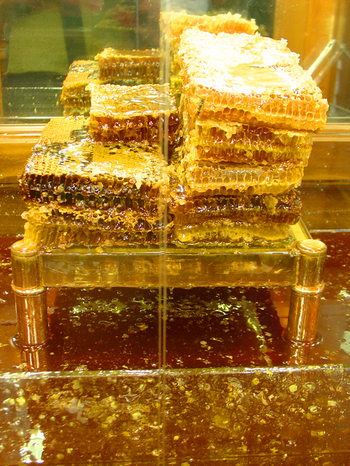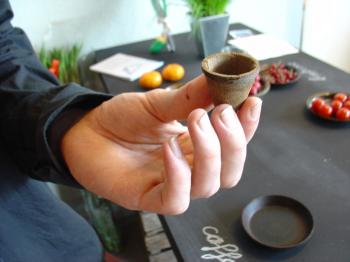Wasteware, it’s everything but the squeal in food recycling
July 4, 2006

Rhubarb and carrot waste formed into little bowls for cherries and berries.
Man and Humanity masters graduate Matthijs Vogels has developed a beautiful but extreme way to eliminate food waste by turning it into plates and bowls. At last week’s Design Academy Eindhoven MFA show, Vogels exhibited a concept restaurant in which all food waste would be recycled into sensual tableware as well as gas fuel for the cooking. Vegetable, fruit, tea, coffee and packaging waste is churned up, moulded under pressure and formed into any shape. The new material, which I am calling wasteware, is reusable, reminiscent of Indian leaf plates and bowls in its simplicity. Wastewear plates and bowls are fully compostable, easy to manufacture anew (even onsite), and are extremely sensually textured, reflecting the materials from which they are made. The material is so pretty that you would be tempted to use the bowls as a storage space for other precious things aside from food. It is as sturdy as a low-heat fired ceramic.
In Vogels’ recycling restaurant concept, SPROUT, guests would receive a small vessel made out of the waste/leftovers from their meal in combination with the restaurant’s leftovers including the composted plates. This souvenir of waste serves to remind guests of the circular system of waste, compost, growing food.

Matthijs Vogels’ recycling concept, this bowl is made out of leek waste.
Want to get in touch with Matthijs Vogels?

Vogels’ food gas can power a burner!
debra at 12:30 | | post to del.icio.us




















That’s pretty fricken’ cool. But I’d like to try it first. Scared it might impart garbage flavors to my new foods. Shudder.
Biggles
Comment by Dr. Biggles — July 7, 2006 @ 0:38
Good observation, Dr. Big, But what is so cool, is that Vogels has \’finished\’ the wasteware material with a potato starch layer, it\’s almost like a plastic or wax film, it gives the material a polished appearance. This layer keeps the smells and dyes and all that transmutable goodness in one place, and allows the bowl/plate/vessel to be washed a few times before wearing off and eventually allowing the bow/plate/vessel to be returned to the composting pile.
BTW: in the Indian leafenware example, the taste of the leaves IS imparted into the food and is considered to be desirable. Obviously this would not be the case when using composted beet or leek pulp. But in the streetfood example the initially undesirable odour of fish is turned into a positive thing. Fish skin holders for chips + drying + a light dusting with vinegar powder and salt = handy sack for fish and chips.
Pity the young Vogels isn\’t here to respond to this comment himself!
Comment by Debra van Culiblog — July 7, 2006 @ 8:23
I wonder if acidic foods would cause the starchy layer to degrade faster. Or if temperature would do the same? Such as hot tea or somethin’.
I wish I was closer so I could play. It would be fun to see how much I could eat/drink out of them until I started to taste garbage in my food. AHHAHAHHAHHA, yes.
Biggles
Comment by Dr. Biggles — July 7, 2006 @ 20:20
Thanks for the comments and creative guesses about the plates, but to avoid further misunderstandings i will give you the whole story. In the conceptual restaurant “Sprout” vegetables are grown and consumed in a greenhouse. The vegetable parts that are not suitable for consumption which are normally thrown away in the kitchen, are used now as resource for products like plates and bowls. This is achieved by shredding, drying and moulding the vegetable fibres with a hand press. In order to make the products hygienic and moisture resistant a transparant sheet of biodegradable plastic (PLA) is laminated in the inside. The outside is left uncovered, in order to reveal the material by smell, touch and sight. Since the menu is based on seasonally grown crops, the material of the products changes accordingly, and are therefore intended to be used only once. After use, the dirty plates and bowls are fed together with foodleftovers to a biodigester to create biogas for cooking. The residue from this process is a nutrient rich fertilizer to grow new crops from in the greenhouse. I hope this clears up some of your questions, otherwise I’d be happy to answer your comments!
Comment by matthijs vogels — July 10, 2006 @ 17:11